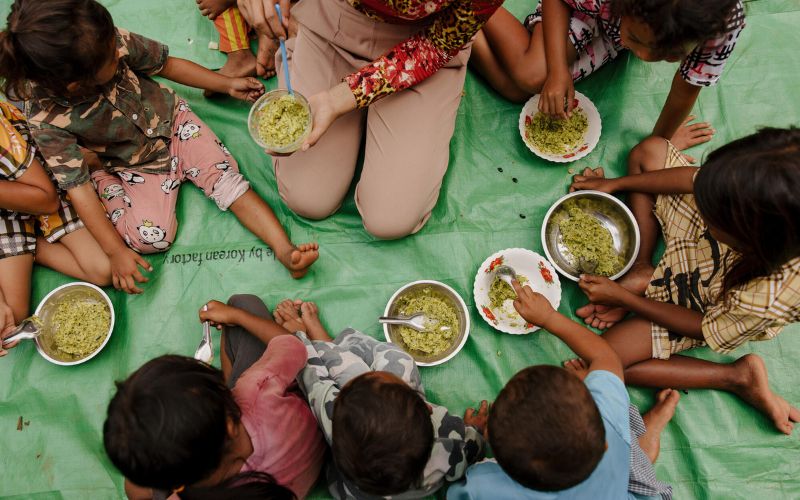The Scene of Difficult Access to Food: Overcoming Challenges in Today's World
Accessing food in certain situations is not always as straightforward as it seems. In daily life, there are numerous scenarios where food can be difficult to obtain. These situations often present significant challenges, causing inconvenience or even distress. In this article, we explore some common scenes of difficult access to food and the issues they create for those affected.
Long-Distance Travel: The Struggles of On-the-Go Meals

Long-distance travel is one of the most prevalent scenarios where access to food becomes a challenge. Whether by plane, train, or car, travelers often find themselves facing limited food options, poor quality meals, or the absence of food altogether.
On airplanes, although meals are typically provided on longer flights, these meals are often unsatisfactory. Airline meals, due to the constraints of the flying environment, can lose much of their taste and freshness. For passengers with specific dietary needs—such as vegetarians, vegans, or people with food allergies—finding meals that meet their requirements can be especially difficult. For example, vegetarian options may be scarce, and finding gluten-free or low-sugar choices is often impossible.
Train travel, too, presents its own food challenges. While high-speed trains may offer a variety of meals, most other trains provide limited options, such as instant noodles, packaged snacks, and processed meats like ham sausage. Furthermore, food carts are often only available at specific times, and passengers who miss these opportunities are left with few options. Long-distance buses present even more difficulties, as there are often no suitable places to buy food along the route. Passengers are left relying on snacks they’ve prepared before the trip or going without.
In all of these scenarios, the need for fresh, satisfying, and nutritious food during travel is clear. Yet, the current infrastructure often leaves travelers struggling with subpar meals and limited choices.
Outdoor Adventures: Navigating the Challenges of the Wild

For outdoor adventurers—whether they are mountain climbing, hiking through forests, or exploring deserts—access to food becomes even more complex. In many remote wilderness areas, food is simply not available.
In the deep mountains or forests, far from human settlements, adventurers often have no access to stores or restaurants. Even if they bring dry food or energy bars, these supplies can run out quickly, especially if the journey extends longer than planned. Unforeseen circumstances such as bad weather, injury, or navigational errors can further exacerbate the situation, leading to food shortages.
Additionally, the lack of conventional cooking equipment in these environments means that adventurers cannot cook fresh ingredients. In the desert, where water is scarce, food preservation becomes even more difficult. The dry food that is packed for such trips may be the only thing available, but once it runs out, there are few options left. Adventurers in such environments are at constant risk of running out of food, which could lead to dangerous situations.
This scenario underscores the importance of proper preparation and the need for convenient, high-energy foods that can last in extreme conditions. Many adventurers rely on dehydrated meals, emergency rations, and specialized food designed for these situations to avoid the risk of hunger during their excursions.
Busy Work Life: Struggling to Eat in a Fast-Paced World

In today’s high-speed, demanding work environment, many people experience difficulties accessing food simply due to time constraints. For office workers, particularly those in high-stress fields like finance, technology, or medicine, meal times can often become a luxury they can’t afford.
For example, employees facing tight project deadlines or sudden meetings may find themselves so immersed in their work that they don’t have time to step away for a meal. Even if they attempt to order food, the delivery services might be delayed, especially during peak hours. Moreover, long-term dependence on food delivery services can lead to concerns about the nutritional balance of one’s diet.
In such fast-paced environments, healthy eating becomes a struggle. Individuals may resort to unhealthy snacks or skip meals altogether due to a lack of time. This can result in an imbalance in nutrition, which affects both physical and mental health. The inability to access balanced meals at the right time can have long-term consequences on overall well-being.
Living or Working in Remote Areas: The Challenges of Geographic Isolation

Living or working in remote areas such as mountain villages, islands, or border regions can bring unique challenges when it comes to food access. In these areas, transportation and infrastructure are often limited, and food supplies may be irregular or inadequate.
For example, remote villages may lack supermarkets, fresh produce markets, or restaurants. Residents often rely on scheduled deliveries of food and essential goods, which can be disrupted by weather conditions or other external factors. If the transportation system is blocked due to a storm or other disaster, food shortages can quickly become a serious issue.
In these areas, people may rely on canned goods, dried food, and preserved items, but these supplies are not infinite. With no easy access to fresh food, the residents of such areas face ongoing challenges in maintaining a balanced and varied diet.
Emergency Situations: Food Scarcity in Crisis Scenarios

Natural disasters such as earthquakes, floods, and typhoons can cut off access to food for entire populations. In these emergency situations, supermarkets and local stores may be destroyed, and transportation routes may be compromised. This can leave affected people with little to no access to fresh food.
During such crises, if people have not stockpiled food or prepared emergency rations in advance, they face the very real threat of hunger. In some cases, trapped individuals may only have access to limited supplies, often with no way to replace them. In these extreme scenarios, food distribution becomes a critical issue for both survival and recovery.
For those stranded or caught in natural disasters, having access to emergency food supplies is essential. Governments, humanitarian organizations, and individuals must plan for these situations by ensuring they have enough food and water on hand in case of emergencies.
The Need for Convenient, Accessible, and Nutritious Food
These diverse scenarios of difficult access to food highlight the growing need for convenient, nutritious, and long-lasting food options. Whether for travelers, adventurers, office workers, remote residents, or individuals facing emergencies, people need food that is easy to store, preserve, and prepare.
The food industry has responded to this need by developing a wide range of products that cater to these unique challenges. From freeze-dried meals for outdoor adventurers to nutritious, ready-to-eat options for busy professionals, the industry is innovating to make food more accessible. Additionally, with the rise of meal kits and subscription services, people can now have fresh, healthy meals delivered to their doorsteps, even in remote areas or during emergencies.
In conclusion, difficult access to food is a prevalent issue that affects many people in various situations. Whether through travel, outdoor adventures, busy work schedules, or geographic isolation, the ability to obtain food can often become a serious challenge. However, with the continued evolution of food products and services, the solutions to these challenges are becoming more accessible, making it easier for individuals to get the nutrition they need, no matter the circumstances.




